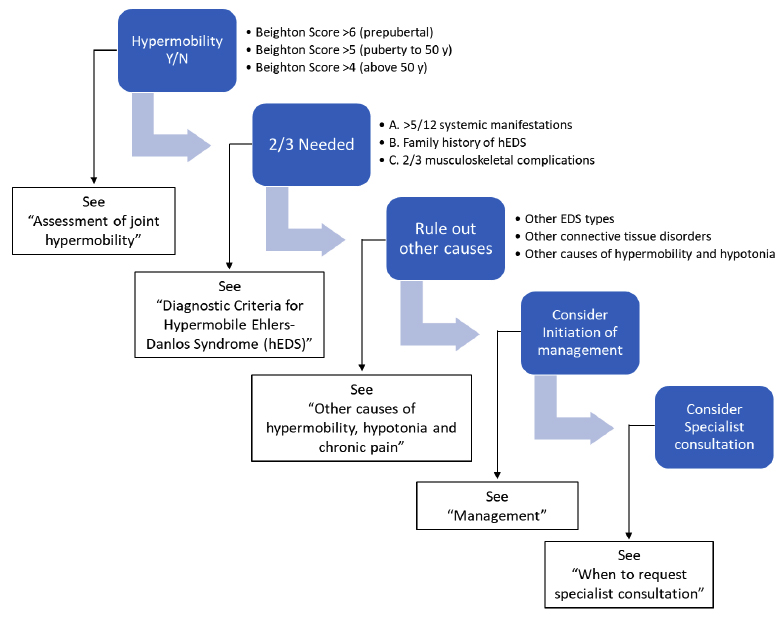Evaluation for Suspected Ehlers-Danlos Syndrome
Questions about children’s joint mobility or laxity are often encountered in primary care, raising the possibility of joint hypermobility syndrome (JHS) or hypermobile Ehlers-Danlos syndrome (hEDS), also known as type 3 or hypermobile type EDS. Generalized joint hypermobility (GJH), estimated to affect 10-20% of the general population and is 3 times more common in females than in males. GJH is often asymptomatic, occurs commonly without other features of JHS/hEDS, and diminishes with age.
Of the 14 described subtypes of EDS, JHS/hEDS is by far the most common. Diagnostic criteria were most recently proposed in 2017 by Malfait, et al. [Malfait: 2017] Many patients with mild to moderate hypermobility can be diagnosed and managed by their primary care (medical home) clinician. Those who are more severely affected will benefit from referral to an experienced subspecialist, usually a rheumatologist or a geneticist.
Recognizing the challenges of recognizing, evaluating, diagnosing, and managing children with signs of JHS/hEDS, the Mountain States Regional Genetics Network (MSRGN) organized a workgroup to develop an algorithm and compile resources to assist. The diagnosis of hEDS is made clinically; no genetic test is currently available. However, genetic testing is available for 13 of the 14 types of EDS and is recommended if relevant findings are uncovered through family or medical history or physical exam. Genetic counseling is advised if testing is to be pursued.
The basics of the algorithm Ehlers-Danlos Syndrome (EDS) Algorithm and Resources for Primary Care (MSRGN) are graphically represented below.
The algorithm includes information about:
- Genetic testing
- Assessment of joint hypermobility
- Diagnosis of JHS/hEDS
- Other causes of hypermobility, hypotonia, and chronic pain (differential diagnosis)
- Management
- When to request specialist consultation
- References and resources for clinicians
- Resources for patients and families
The full algorithm, along with numerous links to resources for patients and families, can be found at Ehlers-Danlos Syndrome (EDS) Algorithm and Resources for Primary Care (MSRGN).
Resources
Information & Support
For Professionals
Mountain States Regional Genetics Network (MSRGN)
The Mountain States Regional Genetics Network (MSGRN), one of seven regional networks, covers an 8 state region. It strives
to ensure that individuals with heritable disorders and their families have access to quality care and appropriate genetic
expertise and information in the context of a medical home.
Tools
Ehlers-Danlos Syndrome (EDS) Algorithm and Resources for Primary Care (MSRGN)
An algorithm for evaluation of children suspected of having hyper-mobile EDS, as well as a variety of resources for patients
and families; developed by the Mountain States Regional Genetics Network
Services for Patients & Families in Ohio (OH)
| Service Categories | # of providers* in: | OH | NW | Other states (4) (show) | | NM | NV | RI | UT |
|---|---|---|---|---|---|---|---|---|---|
| Genetic Testing and Counseling | 6 | 6 | 12 | 8 | 11 | ||||
| Medical Genetics | 1 | 2 | 5 | 4 | 7 | ||||
| Pediatric Rheumatology | 1 | 2 | 2 | 2 | 3 | ||||
For services not listed above, browse our Services categories or search our database.
* number of provider listings may vary by how states categorize services, whether providers are listed by organization or individual, how services are organized in the state, and other factors; Nationwide (NW) providers are generally limited to web-based services, provider locator services, and organizations that serve children from across the nation.
Authors & Reviewers
| Author: | Medical Home Team |
Page Bibliography
Malfait F, Francomano C, Byers P, Belmont J, Berglund B, et al.
The 2017 international classification of the Ehlers-Danlos syndromes.
Am J Med Genet C Semin Med Genet.
2017;175(1):8-26.
PubMed abstract


 Get More Help in OH
Get More Help in OH